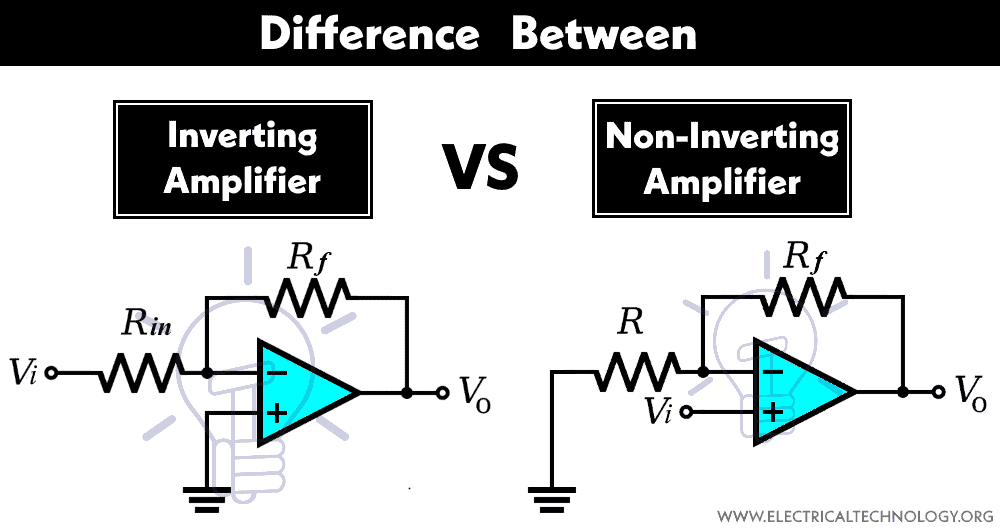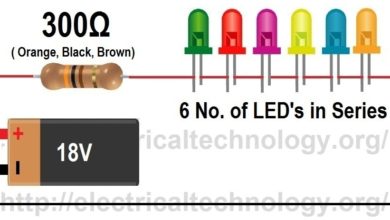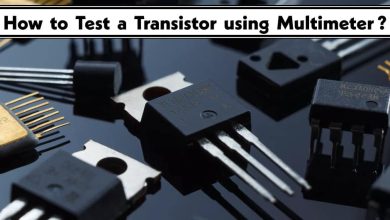Difference Between Inverting and Non-Inverting Amplifier
What is the Difference between Inverting and Non-Inverting Amplifier?
An amplifier is a device that amplifies any signal. Now an amplifier can be inverting or non-inverting; an Amplifier whose output signal is 180 degrees out of phase with the input signal is called inverting while the output of a non-inverting amplifier is in-phase with the input signal.
What is Op-Amp
An op-amp or operational amplifier is a device that is used for the amplification of signals. It uses external components such as resistors and capacitors to perform various operations on signals. It has certain ideal characteristics such as infinite input resistance, zero output resistance, infinite open-loop gain, high bandwidth.
It has three terminals including two inputs and one output terminal. One of the two input terminals is a positive (Non-Inverting) terminal and the other is a negative (inverting) terminal. It is used for mathematical operations on signals such as amplification, addition, subtraction, comparison, integration, filtering, etc.
Before going into the differences between Inverting and non-inverting amplifiers, let’s discuss their basics first.
What is Inverting Amplifier?
An inverting amplifier is a type of amplifier that is designed to produce output that is 180 degrees out of phase with the input signal. As its name suggests, it inverts the phase of the input signal. For example, if we apply a positive voltage signal at its input, its output will be a negative voltage signal.
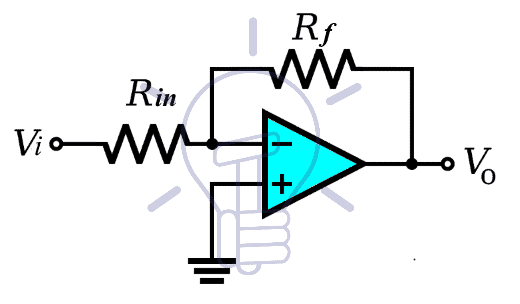
The voltage at both input terminals of an ideal op-amp is equal to each other; this is also known as the virtual short concept. To find the gain of this amplifier, apply KCL at the inverting node.
(0 – Vi) / Rin + (0 – Vo) / Rf = 0
-Vi / Rin – Vo / Rf = 0
Vo / Vi = – (Rf / Rin)
Voltage gain, Av = Vo / Vi = – (Rf / Rin)
Since the amplifier is in inverting configuration, its voltage gain is negative.
Features of Inverting Amplifier
- It amplifies and also inverts the phase of the input signal.
- The output is 180 degrees out of phase with the input signal.
- The input signal is applied at its inverting (Negative) terminal.
- The non-inverting terminal is grounded.
- Its voltage gain is given Av = -(Rf/ Rin)
- Its voltage gain is negative.
- Its gain can be designed to have less than, greater than, and equal to 1.
- Its input impedance is Rin.
What is Non-Inverting Amplifier?
The type of amplifier that is designed to amplify the input signal without changing its phase is called a non-inverting amplifier. Its output is in-phase with the input signal. It does not change the phase of the signal but only amplifies it. As its name suggests, it does not invert the phase of the signal.
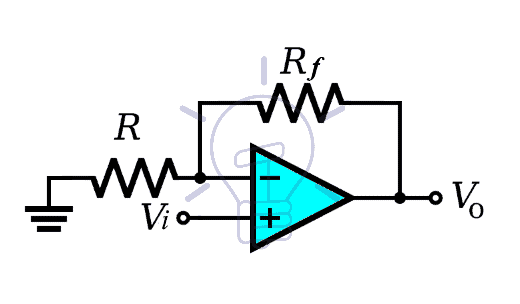
Using the virtual short concept of an ideal op-amp, the voltage at both input terminals is equal i.e. both terminals have Vi. Applying KCL at the inverting node of the op-amp.
(Vi-0) / R + (Vi-V0) / Rf = 0
Vi/R + Vi / Rf – V0 / Rf = 0
Vi (R + Rf) / RRf = V0/Rf
V0 / Vi = (R + Rf) / R
Voltage gain, Av= V0 / Vi = 1 + Rf / R
Since the amplifier is in a non-inverting configuration, the gain is also positive and it is greater than inverting amplifier by 1.
Features of Non-Inverting Amplifier
- It amplifies and does not change the phase of the signal.
- Its output is in-phase with the input signal.
- The input is applied at its non-inverting terminal.
- The inverting terminal is grounded through a resistor.
- Its voltage gain is given by Av = 1 + Rf / R
- It gain is always greater than 1.
- Its voltage gain positive.
- Its input impedance is infinite.
Main Differences between Inverting and Non-Inverting Amplifier
| Inverting Amplifier | Non-Inverting Amplifier |
| A type of amplifier whose amplified output is 180 degrees out of phase with the input signal. | A type of amplifier whose amplified output is in-phase with the input signal. |
| The input and output signal has 180 degrees of phase difference. | The input and output signals are in-phase or have a 0 degree phase difference. |
| The input signal is applied at the inverting terminal. | The input signal is applied at the non-inverting terminal. |
| The non-inverting terminal is grounded. | The inverting terminal is grounded through a resistor. |
| Its gain is given by Av = -(Rf / Ri). | Its gain is given by Av = 1 + (Rf / R). |
| Its gain is the ratio of the resistance. | Its gain is the sum of 1 and ratio of resistance. |
| Its gain can be less than, greater than, or equal to 1. | Its gain will be always greater than 1. |
| It has a lower gain than a non-inverting amplifier. | It has a relatively higher gain. |
| It has a negative voltage gain. | It has a positive voltage gain. |
| Its input impedance is Rin. | Its input impedance in infinite. |
Comparison between Inverting and
- The inverting amplifier inverts the phase of the signal while the non-inverting amplifier does not change the phase of the signal.
- The gain of inverting amplifier is 1 less than the non-inverting amplifier.
- The gain of inverting amplifier can be less than, greater than, or equal to 1 but the non-inverting amplifier gain is always greater than 1.
- The gain of inverting amplifier is negative while the gain of the non-inverting amplifier is positive.
- In inverting amplifier, the input signal is applied at inverting terminal while in a non-inverting amplifier, the input signal is applied at its non-inverting terminal.
- The input impedance of inverting amplifier is Rin while it is infinite in a non-inverting amplifier.
Related Posts:
- Negative Feedback Amplifier Systems
- Operational Amplifier (OP-AMP) – Formulas and Equations
- Push-Pull Amplifier Circuit – Class A, B & AB Amplifier Circuits
- Active and Passive Frequency Filters – Formulas & Equations
- Electronic Filters Symbols – Electrical & Electronic Symbols
- Difference Between Thermistor and Thermocouple
- Difference Between Sensor and Actuator
- Difference between Sensor and Transducer
- Difference Between Clipper and Clamper Circuit
- What is The Difference Between Transistor & Thyristor (SCR)?
- Difference between Active and Passive Components
